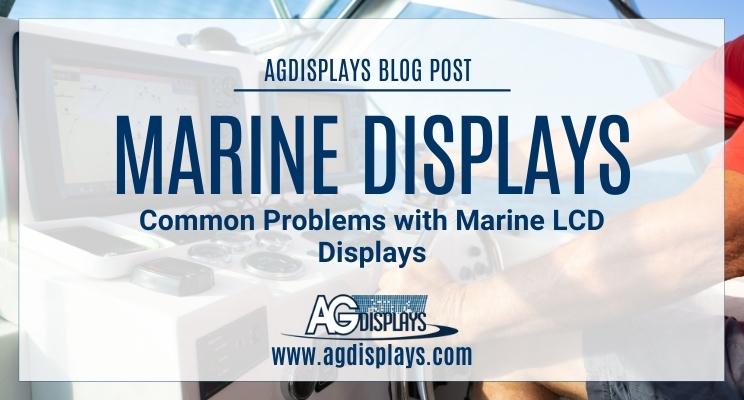Designing an LCD system should consider every element of the application’s environment so that integrating protection can create a system that keeps electronic repairs at bay. Consider the following environmental challenges before designing your marine LCD system.
1 – High outdoor/ambient light
Sun shining directly on a digital screen in outdoor applications can immediately cause frustrating readability issues. Sunlight can temporarily increase glare or almost completely wash out the image on the screen. On a technical level, the UV light from direct sunlight can degrade the internal liquid crystal over time, eventually causing irreparable damage such as color shifting and permanent wash out. These problems can be solved using an LCD with a high bright LED backlighting system, and matte or anti-reflective surface polarizers. The high bright LEDs can outpower the ambient luminance of the environment, causing increased readability in outdoor conditions. Anti-glare polarizers are films that are integrated within the LCD or on top of the LCD, redirecting light to maximize user readability. Other rugged integrations, such as an optical bond, change the way light travels through the LCD, creating less reflective points inside the LCD, enhancing readability, as well as strengthening the LCD overall.
2 – Extreme hot or cold temperatures
Extreme temperature due to direct sunlight, outdoor temperature or other environmental factors can cause components to rapidly degrade. OrientDisplay.com notes, “Liquid crystals are manipulated in a device by altering their orientations and alignments, heat can disrupt this by randomizing what is meant to be controlled,” (Source). If high temperature becomes an issue, the liquid crystal will behave erratically, and the display may produce a variety of failures, such as: dark spots, light spots, an entire black screen, an entire white screen, color failures, and eventual liquid crystal degradation. Components such as bonds, gaskets and films can melt or warp, and electronics like controllers may fail in extreme cases. In the case of extreme cold temperatures, the display will be sluggish (slow response time), may take seconds to minutes to refresh an image, and the LCD will display improper colors. Cold temperatures are less likely to permanently damage a display, though is still an issue of concern. These problems can be corrected by selecting the widest temperature range displays available. Your designs can also integrate solutions like fans, heaters, and heater-glass to manage hot/cold extremes, if necessary for your design/application.
3 – Moisture
Water (fresh, and especially salt water) can quickly degrade/corrode electronic components and metal equipment. Displays, cables, and components exposed to open water should be shielded against water ingress to prevent failures. Any metal chassis or frame of the display should be properly shielded to prevent rust and corrosion.
If possible, to avoid this problem by preventing exposure to mist/water, remove the display from the wet environment or employ a custom wind or spray shield. Integrate IP rated components, optical bonding and gasketing into your design, and regularly clean and treat the display. Tune your touch screen to be used with wet fingers. Learn more about our touchscreen integration services here.
4 – Dust and other contaminants
Dust and contaminants, whether inside or outside of the display, can cause mis-readings for the user. Excess dust inside of the display can additionally create overheating and potential short circuiting. If not regularly cleaned and removed, dust on a touch display may interfere with the accuracy of touch sensors. Conversely, if a damaged LCD is leaking is liquid crystal, harmful chemicals from the display may potentially leak and be found near the display as dry dust. Solve this by completing thorough quality control inspection, adding IP-rated gasketing into your design and regular cleaning/maintenance.
5 – Movement and vibration
Rough seas will cause a deal of vibration and movement to the display. A common LCD point of failure in high vibration is the printed circuit board or PCB. The PCB controls power management, the LCD controller, and other components. It is usually the point in which a connection, fastener, or solder point will crack and fail after vibrating. Aging or weakened gaskets and other rubber components can develop fractures which can lead to failure. Strengthen your display by integrating ruggedized components, optical bonding, and rugged metal or plastic enclosures.
6 – Impact
Impact to an LCD can damage and break the outer cover glass, touch screen, or the Liquid Crystal glass itself. Impacts can cause dangerous situations with broken glass and leaking toxic chemicals. Strong impacts can destroy the display and its accompanying components entirely. Ruggedize your display to protect against these situations by using chemically strengthened glass paired with an thickened optical bonding for extra protection. There are many different types of substrates that offer various rugged features, based on the unique need of your application. Read more about our custom glass integrations here.
By employing high quality rugged components and enhancements, your display is more likely to withstand vibration and other movement. Paired with regular maintenance, your rugged marine system can outlast it’s expected lifespan and continue working without issues for the life of your boat.


